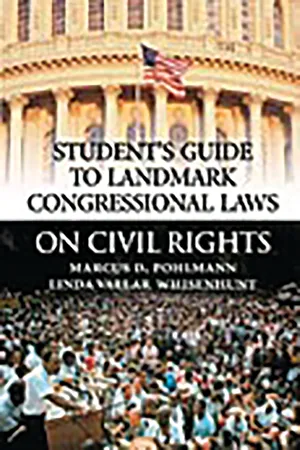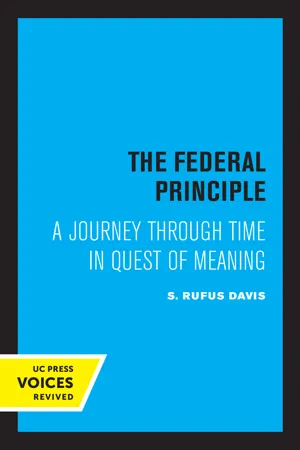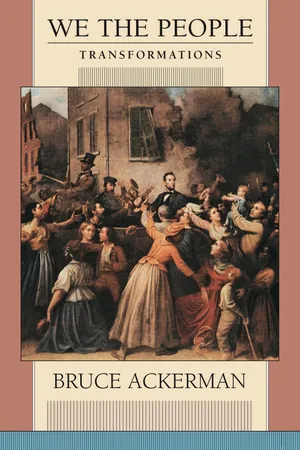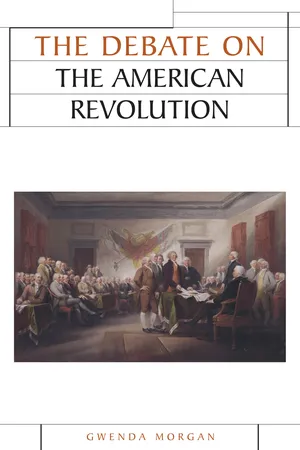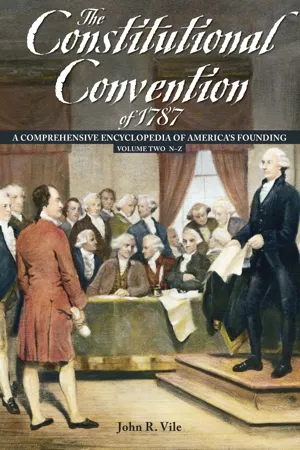Politics & International Relations
Articles of Confederation
The Articles of Confederation was the first constitution of the United States, adopted in 1777 and ratified in 1781. It established a weak central government with most power held by the individual states. The Articles ultimately proved ineffective in governing the nation, leading to the drafting of the U.S. Constitution in 1787.
Written by Perlego with AI-assistance
Related key terms
1 of 5
9 Key excerpts on "Articles of Confederation"
- Marcus D. Pohlmann, Linda Vallar Whisenhunt(Authors)
- 2002(Publication Date)
- Greenwood(Publisher)
It apportioned one representative per state, even though states like Massachusetts and Virginia had considerably larger pop- ulations. It also recommended assessing taxes by the total number of persons in the state, black as well as white, angering Southerners who did not feel slaves should be counted for that purpose. The document passed by the Continental Congress bore little resemblance to Dickinson's initial plan. In the end, the Articles of Confederation and Perpetual Union, somewhat hastily pieced to- gether, passed on November 15, 1777. Ratification, however, would 4 THE SLAVERY PERIOD be considerably slower, given heated disagreement over whether the new Congress was to be authorized to settle disputes about own- ership of western territories. Maryland, the final holdout, did not ratify the Articles until March 1, 1781, when the British military began to pose a serious threat to the Chesapeake region. Finally the Articles became the nation's first actual constitution. This document was not a philosophical treatise setting out con- ceptions of freedom and governmental power; instead, it focused on creating a national government with the wherewithal to wage a war, while leaving virtually all else to the several states. Conse- quently, the individual states retained considerable sovereignty un- der the Articles of Confederation, as very little independent authority was delegated to a national government, and the role of the president was severely constrained as well. As Edward Rutledge, a delegate from South Carolina, put it, the new national government had been delegated "no more Power than is absolutely necessary." 1 This understanding was quite clearly stated in Article II, proposed by Thomas Burke of North Carolina and passed by eleven of the thirteen delegations.- eBook - PDF
Forging the American Nation, 1787-1791
James Madison and the Federalist Revolution
- Shlomo Slonim(Author)
- 2017(Publication Date)
- Palgrave Macmillan(Publisher)
CHAPTER 1 America’s First Constitution: State Over Nation There is nothing more common than to confound the terms of the American revolution with those of the late American war. The American war is over: but this is far from being the case with the American revolution. On the contrary, nothing but the first act of the great drama is closed. It remains yet to establish and perfect our new forms of government; and to prepare the principles, morals, and manners of our citizens, for these forms of government, after they are established and brought to perfection. Benjamin Rush, 1786 1 It is to this [requirement of] unanimous consent, [that] the depressed situation of the Union is undoubtedly owing … To this weak, this absurd part of the Government, may all our distresses be fairly attributed. Charles Pinckney, 1787 2 It is well recognized that in the space of the first 11 years of its existence, the United States experienced not one, but two revolutions. The first was the political revolution of 1776 that severed the bond between the 13 colonies and Great Britain and proclaimed, in the Declaration of Independence, the sover- eignty of the United States. But it was only in the second, 1787 revolution, that the states were welded into one nation under a central governing authority by means of the Constitution. The defects that marked the initial political system established under the Articles of Confederation were legion. As analyzed by Alexander Hamilton in Federalist #15 and successive numbers of the Federalist Papers, they included primarily such matters as the inability of the Confederation Congress to levy taxes directly on individuals and its dependence for revenue on the oft-unfulfilled requisitions leveled against the states; the disarray in interstate and foreign commerce due to conflicting state policies and imposts; the undermining of the confederation’s foreign relations by the states’ pursuit of independent foreign © The Author(s) 2017 S. - eBook - PDF
War, Revenue, and State Building
Financing the Development of the American State
- Sheldon Pollack(Author)
- 2011(Publication Date)
- Cornell University Press(Publisher)
95 It is no coincidence that under the Articles of Confederation, the national government lacked the authority to impose its own taxes. The state legislatures were unwilling to concede any portion of this essential power to the Congress. At the same time, pro-ponents of a strong national state were too weak to force any significant change to the status quo. In negotiating with local authorities for greater revenue for the national government, they proved too weak to impose a more favorable revenue strategy (from their perspective) on the states. 93. While there was no executive, there was a president of the Congress beginning with the First Continental Congress. In all, fourteen different presidents presided over the Congress be-tween 1774 and 1789. The weaknesses of the institution of the presidency of the Congress are dis-cussed in Jillson and Wilson, Congressional Dynamics, 71–90. 94. “Each state retains its sovereignty, freedom, and independence, and every power, juris-diction, and right, which is not by this Confederation expressly delegated to the United States, in Congress assembled.” Articles of Confederation, art. II. 95. This limitation on the tax power of the new government was intentional. In his study of public finance during this period, Ferguson argued that “after independence [eighteenth-century Americans] tried to safeguard the sovereignty of their new states under the Articles of Confeder-ation by denying Congress the right to tax.” Ferguson, Power of the Purse, xv. State Formation in the Early Republic 155 What revenue powers were granted the national government under the Articles of Confederation? The Congress relied entirely on the state leg-islatures for revenue. The Congress was authorized to “assess” the states, subject to a requirement that such revenue assessments be apportioned to the several states in proportion to the value of all land and improvements within each state. - eBook - PDF
The Federal Principle
A Journey Through Time in Quest of Meaning
- Rufus S. Davis(Author)
- 2023(Publication Date)
- University of California Press(Publisher)
But the Convention of 1787 and the ratification debates knew only one immediate and practical necessity: to take what steps they could to improve the evident deficiencies of the political system embodied in the Articles of Confederation. To have attempted to append a manual of political conduct 116 The Federal Principle appropriate to the new Constitution would have involved the delegates in discoursing and agreeing on many things: how, for example, the two governments should regard each other in the exercise of their powers, whether they should act in total iso- lation from each other, or join together, whenever possible, in carrying out their activities; on the nature of the duty of care they owed each other, if any; on the nature of injury, pressure, coercion, influence, and manipulation; they would have had to prescribe what political stratagems could be used or not used in relation to each other; they wo"ld have had to comment on the use of financial resources, political groups, and powerful indi- viduals to circumvent, extend, amend, reduce, frustrate, deflect, or diminish the policies of the national government by the states, the states by the national government, and states by states; they would have had to propose the kinds of activity which maintain and those which destroy the "balance" or "equilibrium" of the Constitution; and much more. But not only would this enterprise have been a labor of Sisyphus, not only would such a manual have to be written differently for each set of political presumptions about the meaning of "co- ordinate," "co-equal," "independent," and "sovereign" status, not only would it produce the generalities of ideology which make poor guides to action, but like Canute it would have at- tempted the impossible political task of prescribing and pro- scribing political conduct for a society not given to political prescription. - eBook - PDF
- Bruce Ackerman(Author)
- 2000(Publication Date)
- Belknap Press(Publisher)
Article XIII’s emphasis on unanimity is hardly accidental, since it took a lot of work to get all of the states to agree to the terms of Confedera-tion in the ªrst place. 4 And yet the Federalists were now refusing to play by the rules. After a summer of secret meetings, they went public with a bombshell. Article Seven blandly asserted that “[t]he Ratiªcation of the Conven-tions of nine States shall be sufªcient for the Establishment of this Constitution between the States so ratifying the Same.” This declara-tion of independence created three sorts of legal problems. Problems under the Articles Article Seven assaults the established revisionary process on four fronts. First, it invited secession, rejecting the Articles’ assertion that “the Union shall be perpetual” and authorizing a walkout of nine states. As we shall see, this threat of secession was crucial in pushing states like New York and Virginia to give the Constitution their reluc-tant endorsement. The ªrst Congress after ratiªcation began as a secessionist body, meeting without North Carolina or Rhode Island— and the latter state’s consent was only procured after the secessionist Congress began threatening it with economic sanctions. Second, the Founding text ignored the power over amendments 34 w e the people: transformations granted by the Articles to the Continental Congress. This omission was especially remarkable since a number of states refused to send delegates to Philadelphia until the Constitutional Convention re-ceived express Congressional approval. The Federalists were no less contemptuous of existing state authori-ties. In the teeth of the Articles’ express command, their proposed Constitution cut the legislatures out of the ratifying process, leaving it up to special conventions meeting in each state. Finally, all this was done in the face of the Articles’ express claim to specify the exclusive means for its revision. - eBook - PDF
American Government
Institutions & Policies
- James Wilson, John DiIulio, Jr., Meena Bose, Matthew Levendusky, James Wilson(Authors)
- 2021(Publication Date)
- Cengage Learning EMEA(Publisher)
2-1 The Problem of Liberty 25 with England in 1783. It could coin money, but there was precious little to coin; it could appoint key army officers, but the army was small and depended for support on independent state militias; it was allowed to run the post office, then, as now, a thank- less job that no one else wanted. In 1785, John Hancock was elected to the meaningless office of “president” under the Articles and never showed up to take the job. Several states claimed the unsettled lands in the West, and they occasionally pressed those claims with support him. The supply and financing of his army were based on a series of hasty improvisations, most adminis- tered badly and few supported adequately by the fiercely independent states. When peace came, many parts of the nation were a shambles. At least a quarter of New York City was in ruins, and many other communities were nearly devastated. Though the British lost the war, they still were powerful on the North American continent, with an army available in Canada (where many Americans loyal to Britain had fled) and a large navy at sea. Spain claimed the Mississippi River Valley and occupied what are now Florida and California. Men who had left their farms to fight came back to discover themselves in debt with no money and heavy taxes. The paper money printed to finance the war was now virtually worthless. Weaknesses of the Confederation The 13 states had formed only a faint semblance of a national government with which to bring order to the nation. The Articles of Confederation, which went into effect in 1781, created little more than a “league of friendship” that could not levy taxes or regulate com- merce. As summarized in the above chart (Figure 2.2), each state retained its sovereignty and independence, each state (regardless of size) had one vote in Congress, 9 (of 13) votes were required to pass any measure, and the delegates who cast these votes were picked and paid for by the state legislatures. - eBook - PDF
- Gwenda Morgan(Author)
- 2024(Publication Date)
- Manchester University Press(Publisher)
3 Present at the creation: the making of the Federal Constitution The first hundred years The men who gathered at Philadelphia in the summer of 1787 for the stated purpose of revising the Articles of Confederation agreed to keep their proceedings secret. This in itself was not exceptional but the fact that they remained silent so long has complicated the task of historians ever since. It was particularly galling for those constructing historical narratives in the early republic. 1 Yet these early writers, dismissed in some cases as scrib- blers ‘long and justifiably forgotten’, developed a number of themes which continue to engage historians in the twenty-first century. 2 Lacking material on the Constitution, they dwelt on the period of the Confederation. They were the original exponents of the ‘critical period’ thesis associated with the work of the great popularist John Fiske later in the nineteenth century. 3 While Daniel Shays, veteran of the revolutionary war and putative leader of the 1786 rebellion in Massachusetts which bears his name, became the embodiment of all that was wrong with the government of the Confederation and those of the states, the framers of the Constitution, re-cast as men of heroic stature, seized the initiative. Meeting in Philadelphia, with calm delibera- tion these men abandoned the Articles of Confederation in favour of a new form of republican government. In the work of histori- ans in the early republic and later nineteenth-century historians, the Federal Constitution emerged as the culmination of the Revolution. The American Revolution ‘was a work of thirteen years’ declared John Quincy Adams: ‘The Declaration of 95 - eBook - PDF
The Powers of War and Peace
The Constitution and Foreign Affairs after 9/11
- John Yoo(Author)
- 2008(Publication Date)
- University of Chicago Press(Publisher)
1 2 3 4 5 6 7 8 9 10 11 12 13 14 15 16 17 18 19 20 21 22 23 24 25 26 27 28 29 30 31 32 33 34 35 36 37 [First Pa g [55], (1) Lines: 0 t o ——— 0.0pt P ——— Normal P PgEnds: T [55], (1) 3 Foreign Affairs and the Prelude to the Constitution Although the war and treaty powers may not have been as central to the Revolution as the issue of taxation, the relationship between the leg-islative power and foreign affairs was bound up in the dispute between colonies and mother country over the nature of sovereignty. We can un-derstand the constitutional arguments of the revolutionaries as a defense of the rights of popularly elected assemblies to tax and enact internal leg-islation, rights they felt to be threatened by the foreign affairs power exer-cised by a central government. This chapter discusses the balance between the foreign affairs power and the legislative power as illuminated by the colonial charters, state constitutions, and the Articles of Confederation. Although Blackstone and the Articles of Confederation have been the pri-mary focus of scholarly attention, colonial charters and state constitutions deserve a central place in the historical debate. The colonies, and later the states, provided the Framers with a shared system of reference with which to understand the workings of government. Colonial governments pro-vided examples of legislative participation in foreign affairs through the appropriations power. State governments provided working examples of a separate executive branch. As the most significant governmental legal documents of their day, state constitutions provided the most relevant le-gal context for construing the meaning of the federal Constitution. State experience prior to the drafting of the Constitution demonstrated both the dangers and the advantages of a strong executive. While the revo-lutionaries had rebelled against the power of the royal governors,they also bore witness to the excesses of the postrevolutionary state legislatures. - eBook - PDF
The Constitutional Convention of 1787
A Comprehensive Encyclopedia of America's Founding [2 volumes]
- John R. Vile(Author)
- 2005(Publication Date)
- ABC-CLIO(Publisher)
Antifederalists generally con- ceded that this was so but tended to worry more about the possible implications of a stronger na- tional government for the protection of domestic freedoms (Marks 1971). Marks observed that the new Constitution received especially strong sup- port from men who had dealt with foreign affairs under the Articles of Confederation, among indi- viduals who had studied abroad, among men of foreign birth, and among men with experience on the national level, including involvement with the military (Marks, 466–468), all of whom were presumably more cosmopolitan in outlook than those without similar experiences. Further Observations David Hendrickson has likened the federal con- vention to “an international conference, con- ducted in secrecy among diplomatic plenipoten- tiaries of the states” (2003, 259). He further observes that “the Constitution also incorporated, while domesticating, the hoary doctrine of the balance of power, and indeed projected it into the interior of federal government” (259). Foreign affairs remained an important issue during the early years of the new republic when the Federalist Party found itself more frequently allying with Great Britain and the Democratic- Republican Party more frequently expressing its sympathy for France. See Also Articles of Confederation; Canada; France; Great Britain; Indians; Jay-Gardoqui Negotiations; Shays’s Rebellion; Spain; Treaty-Making and Ratification foreign affairs and the convention 280 for further reading Farrand, Max, ed. 1937. The Records of the Federal Conven- tion. 4 vols. New Haven, CT: Yale University Press. Hendrickson, David C. 2003. Peace Pact: The Lost World of the American Founding. Lawrence: University Press of Kansas. Madison, James. 1973. “Vices of the Political System of the United States, April 1787.” The Mind of the Founder: Sources of the Political Thought of James Madi- son. Ed. Marvin Meyers. Indianapolis, IN: Bobbs- Merrill.
Index pages curate the most relevant extracts from our library of academic textbooks. They’ve been created using an in-house natural language model (NLM), each adding context and meaning to key research topics.
